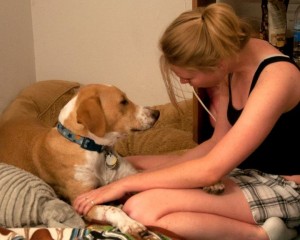Michael Baugh, CPDT-KA, CDBC
There are few things more controversial in the dog world than this plain-spoken statement. You don’t have to use intimidation, pain or fear to train a dog. It is, of course, the truth. We have century-old behavior science to back it up, hard evidence from dogs and dozens (if not hundreds) of other species. Still, if you put the idea out there people will balk. Humans are, in so many ways, a punishing species focused squarely on what is bad and how to “correct” it. So many trainers still use fear and pain as a first choice in handling dogs. Others fall back on it for “certain dogs” or “harder cases.” They defend their positions with the fiction there will be “a case in which the dog’s life is at stake.” Some dogs, they say, need to be punished. They use more acceptable words like “firmness” and “discipline.” The irony is that we won’t tolerate abuse of dogs in other contexts, but we tolerate it in training. Rescue groups lament the suffering their fur babies have endured at the hands of ignorant former owners. Some even suppose abuse that may have never actually happened. Then these same rescue groups refer their dogs to people who openly and shamelessly brutalize and terrorize dogs in the name of training.
These are the same people, trainers and self-professed dog advocates, who will hurl their anger at the truth. They will ignore the evidence of sound behavior science. They will punish the facts here as they punish dogs, without thought or regard for what is right. Some have already begun typing their fury in response to these words. So be it. This essay is not for them.
This is, instead, for the growing majority of trainers and behavior consultants who understand that the best learning happens in a relaxed, pain-free environment. It’s for those who know that training is about contingencies and attaching value to behavior. This essay is for those intelligent people who’ve already discovered that our relationship with dogs isn’t about who’s in charge; it’s about how we learn to communicate together. They are the people who learn and teach and remember every day that training isn’t something we do to dogs; it’s something we do with them. These words are for the reward-driven, science-based trainers who would never inflict fear or pain on any dog. This essay is for them and it’s an open challenge, a call to action.
Find your voice and be heard. Set your own fear aside. Take solace in knowing that you are not only technically correct in your methods but also morally sound. Stop waiting for change. Make change happen.
There was a time when we thought the best way to eliminate pain-based training was to include it in our ranks, and educate the perpetrators. That time has passed. The Association of Pet Dog Trainers is now peppered with trainers who proudly use shock collars, prong collars and choke chains, trainers who throw things at dogs and shake cans at them, and trainers who all the while call themselves “positive.” They are using The Association brand, founded on creating better trainers through education, and refusing to use that education to better themselves. We must insist that our professional organizations set clear standards that reject pain and fear in training.
There was a time when certification was novel and a choice for the few. Others were satisfied to opt out and rest on their own good reputations and skills. That time, too, has passed. If we do not distinguish ourselves collectively, we will be marginalized summarily. The American Veterinary Society of Animal Behavior recently published it’s “10 Life Threatening Behavior Myths about Dogs.” It’s a handout for veterinarians to give to their clients. Myth #9 is “Oh he has a behavior problem? Send him to a trainer.” The “myth” discourages contacting trainers for help, and instead encourages clients to consult their veterinarians (many of whom have no behavior education). The veterinary community is being encouraged by their own leadership to marginalize our hard-fought expertise and professionalism as mythology. We must insist on certification (if not licensure) within our profession if we are going to insist that other allied professionals recognize us.
There was a time when we were the new age trainers, the soft alternative to “traditional” trainers. That time has passed, as well. We are not the alternative. We are the standard-bearer. There is no more time for ignoring the unacceptable behavior of pain-based trainers. We all know that ignoring what is wrong is not enough to bring about change. We don’t just ignore bad behavior; we starve it. Let pain-based trainers (and those organizations who recommend them) wither in a market in which you flourish. Focus your attention (and the attention of others) on the excellence of your work, and celebrate the means to those ends. You are correct and morally sound. Be heard. Raise the banner high and let it be known that science-based and reward-driven training isn’t one way to train; it’s the way to train both quickly and effectively. You know that is true. We must speak this truth and speak it loudly.
There was a time when we could afford in-fighting and back biting among ourselves. We played at competition with each other to our own demise. Time’s up. In Houston, many of the best reward-driven like-minded trainers in the market meet monthly. We call each other with tough cases and refer to each other freely and frequently. We are competitors and friends. We work hard to secure each other’s success. We also hold each other accountable under a common goal to eliminate the use of fear and pain in the name of training. Our success individually and collectively helps dogs escape horror and brutality. To that end, we must work together; and we do.
I remember a time when the future of dog training seemed assured. Education alone would lead us to a time when all dogs were taught gently and intelligently. The only dog whisperer was Paul Owens, and no one hurt dogs on TV for the sake of infotainment. No one worried about a coming “culture war” in dog training. In time, pain-based training would just go away. All we had to do was wait. That time never came. It won’t, unless we act.
We must reject pain-based training immediately and thoroughly. Reclaim your professional organizations. We must demand professional recognition from ourselves and our peers. Certify and license dog training. We must challenge ourselves to be the standard-bearers of training. Starve out those who frighten and hurt dogs. We must come together. There’s no doing this alone.
These words are for you dear fellow trainers who are kind of heart, intelligent and gentle. These words will bring on attacks, to be sure. Cast them aside. Humans are a hard species, especially when someone speaks out. Nothing is more controversial, it seems, than the truth.


